First I’d better define my terms. By narcissus, I mean plants in the genus Narcissus, which many know as daffodils or jonquils. By heirloom, I mean that I inherited them. There is probably an official definition of “heirloom” as relates to Narcissus, but I don’t know what it is. I have seen some of my daffodils called heirloom in other places, but I haven’t made a positive i.d. on all of them, so the names by which I call them have either been discovered after some research or simply made up. I will describe them all in order of their bloom time.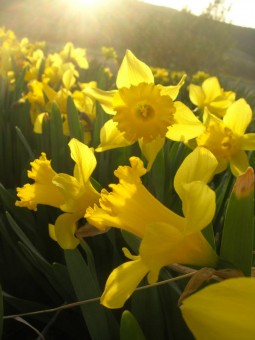 Several of the heirloom narcissus that are growing in my garden now were growing here when I arrived. Most of them, however, were growing blind, and I didn’t know what I had. (Growing blind means foliage is coming up but there are no flowers. One cause of this is overcrowding due to not being divided for years and years.) I dug them up, divided and replanted them, and it sometimes took two or three years before I was rewarded with a blossom. These trumpet daffodils bloom early, earlier than the ‘Rijnveldt’s Early Sensation’ planted elsewhere on the property, and as you might suspect of a plant that survives long periods of neglect, they bloom and grow vigorously. How fortunate that I planted them near the road, where the whole neighborhood can enjoy them.
Several of the heirloom narcissus that are growing in my garden now were growing here when I arrived. Most of them, however, were growing blind, and I didn’t know what I had. (Growing blind means foliage is coming up but there are no flowers. One cause of this is overcrowding due to not being divided for years and years.) I dug them up, divided and replanted them, and it sometimes took two or three years before I was rewarded with a blossom. These trumpet daffodils bloom early, earlier than the ‘Rijnveldt’s Early Sensation’ planted elsewhere on the property, and as you might suspect of a plant that survives long periods of neglect, they bloom and grow vigorously. How fortunate that I planted them near the road, where the whole neighborhood can enjoy them.
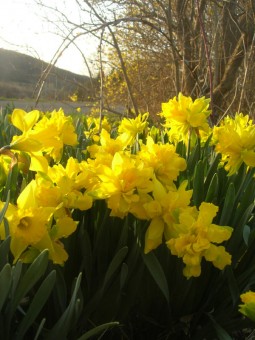 These are interplanted with the trumpet daffodils along the road. I had no idea I had two different kinds of daffodils on my hands, and I had never seen any like this. This daffodil is known as ‘Van Sion’ or ‘Telamonius Plenus.’ According to Scott Kunst of Old House Gardens (OHG), when at its best the “doubling is neatly contained within the trumpet.” I have a vague memory of seeing one or two like that, sort of like finding a four-leaf clover. The blossom in the lower right corner of the photo is about as neat and tidy looking as mine ever get. More often the petals look almost shredded, rightly earning the common name I understand they have in the South: green and yellow mops. And they are pleasantly, though not strongly, fragrant.
These are interplanted with the trumpet daffodils along the road. I had no idea I had two different kinds of daffodils on my hands, and I had never seen any like this. This daffodil is known as ‘Van Sion’ or ‘Telamonius Plenus.’ According to Scott Kunst of Old House Gardens (OHG), when at its best the “doubling is neatly contained within the trumpet.” I have a vague memory of seeing one or two like that, sort of like finding a four-leaf clover. The blossom in the lower right corner of the photo is about as neat and tidy looking as mine ever get. More often the petals look almost shredded, rightly earning the common name I understand they have in the South: green and yellow mops. And they are pleasantly, though not strongly, fragrant.
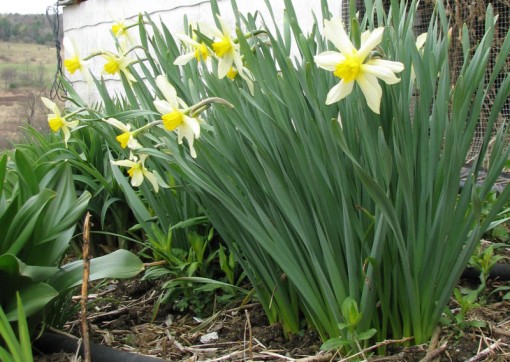 These are my favorites,blooming mid-season. The first time I saw them bloom, I thought, “How sweet!” and dubbed them ‘Kathy’s Sweetheart.’ (True confession: I am capable of bending over a flower and saying, “What a sweetheart you are!” but I would never say that to a dog or a cat. The only cat I ever appreciated was an expert rodent hunter yet very tolerant of young children, and I was perfectly content to let my children do the petting, cuddling, etc.) Debi Lampman, owner of Bedlam Gardens in King Ferry, NY, calls them Butterfly Daffs, because they flutter in the breeze like butterflies. And I have often wondered if they are the same flower that Fedco calls ‘Sara’s Stars:’
These are my favorites,blooming mid-season. The first time I saw them bloom, I thought, “How sweet!” and dubbed them ‘Kathy’s Sweetheart.’ (True confession: I am capable of bending over a flower and saying, “What a sweetheart you are!” but I would never say that to a dog or a cat. The only cat I ever appreciated was an expert rodent hunter yet very tolerant of young children, and I was perfectly content to let my children do the petting, cuddling, etc.) Debi Lampman, owner of Bedlam Gardens in King Ferry, NY, calls them Butterfly Daffs, because they flutter in the breeze like butterflies. And I have often wondered if they are the same flower that Fedco calls ‘Sara’s Stars:’
Flowers open with six distinct light yellow daisy-like petals (the stars) surrounding a small yellow cup. Petals fade toward white as the blooms mature. We’ve been on the trail of their official name for years. Sara brought them to Maine in the early 1960s from Brookline, MA. Durable and prolific.
That’s exactly how they do for me: open yellow and fade toward white. And I think I finally discovered their true name (not that I’m going to stop calling them ‘Kathy’s Sweetheart’). The picture of ‘White Lady’ in the Old House Gardens online catalog seems to match the flower in my garden. It was introduced in 1897. My house was built before then, so now I get to wonder which occupant is the one who planted the original bulb(s) from which mine are descended. And did they actually buy some, or did another gardener pass them along? Neither Fedco nor OHG mentions that these flowers are sweetly fragrant as well as demure and delicate, which I find surprising. Why do so many companies leave out fragrance in their catalog descriptions?
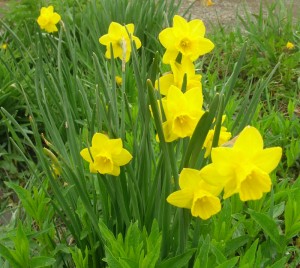 These were given to me by my sister-in-law, who got them from someone else. They look pretty much like OHG’s picture of ‘Trevithian’ or maybe even ‘Sweetness,’ yet these jonquils listed in the OHG catalog are considered hardy only to Zone 6. Well, we all know hardiness zones can be wrong, don’t we? They hardly bloomed at all for several years, and then this year they bloomed like crazy. The big difference, I think, is that last summer it was especially hot. And their fragrance is wonderful, but not like what I associate with daffodils–these little guys smell like honeysuckle. The most I can conclude is that they must at least have jonquil ancestry in them, even if they’re not pure jonquils. I wonder if I can find a “hot spot” for them, so they’ll bloom more consistently?
These were given to me by my sister-in-law, who got them from someone else. They look pretty much like OHG’s picture of ‘Trevithian’ or maybe even ‘Sweetness,’ yet these jonquils listed in the OHG catalog are considered hardy only to Zone 6. Well, we all know hardiness zones can be wrong, don’t we? They hardly bloomed at all for several years, and then this year they bloomed like crazy. The big difference, I think, is that last summer it was especially hot. And their fragrance is wonderful, but not like what I associate with daffodils–these little guys smell like honeysuckle. The most I can conclude is that they must at least have jonquil ancestry in them, even if they’re not pure jonquils. I wonder if I can find a “hot spot” for them, so they’ll bloom more consistently?
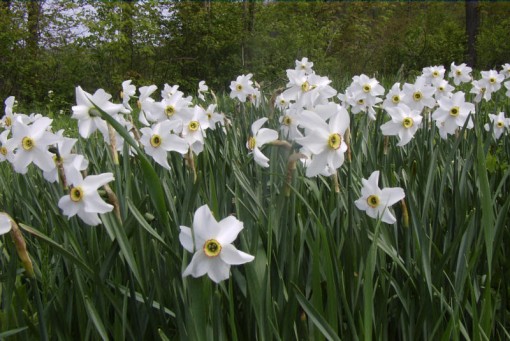 Narcissus poeticus [recurvus]: These were here when we moved in, and I also got some from my in-laws in 1993. They are often called Poet’s Narcissus or Pheasant’s Eye, but in my husband’s family they are simply called narcissus (as opposed to daffodils). I believe they were growing on the land when his parents moved in. They grew in rows in a field, almost as if someone had raised them to sell at one point. These are the first flowers my husband ever gave me, and my first introduction to the concept that daffodils are fragrant, so they will always hold a special place in my heart. You might even say they are a family emblem as well as an heirloom, and they were incorporated in the original logo for this website. White Flower Farm describes them nicely:
Narcissus poeticus [recurvus]: These were here when we moved in, and I also got some from my in-laws in 1993. They are often called Poet’s Narcissus or Pheasant’s Eye, but in my husband’s family they are simply called narcissus (as opposed to daffodils). I believe they were growing on the land when his parents moved in. They grew in rows in a field, almost as if someone had raised them to sell at one point. These are the first flowers my husband ever gave me, and my first introduction to the concept that daffodils are fragrant, so they will always hold a special place in my heart. You might even say they are a family emblem as well as an heirloom, and they were incorporated in the original logo for this website. White Flower Farm describes them nicely:
the true Pheasant’s Eye, with strongly reflexed white petals; a small, red-rimmed yellow cup; and a spicy fragrance. It’s also one of the very last Daffodils to bloom. Heirloom, early 1800s. Very late.
I think of them as blooming at the same time as our apple trees, but this year the apple trees bloomed first. Here they line the path into the Secret Garden: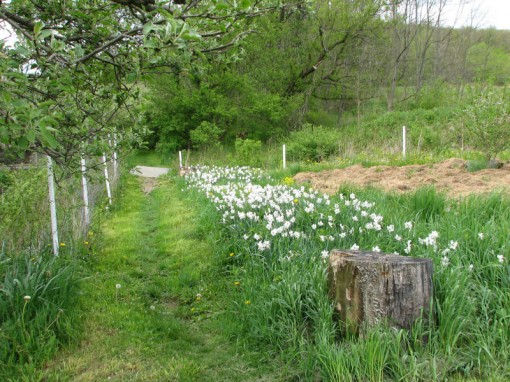
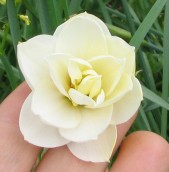 This is the double form of Poet’s Narcissus, also known as Narcissus poeticus var. odoratus ‘Albus Plenus’ or Albus Plenus Odoratus if you go way back. I have always found the double and the single growing together, and it is my understanding (though I can’t find it mentioned anywhere) that it is a naturally occurring sport of the single Narcissus poeticus.
This is the double form of Poet’s Narcissus, also known as Narcissus poeticus var. odoratus ‘Albus Plenus’ or Albus Plenus Odoratus if you go way back. I have always found the double and the single growing together, and it is my understanding (though I can’t find it mentioned anywhere) that it is a naturally occurring sport of the single Narcissus poeticus.
Snowy white and richly fragrant, double pheasant eyes are one of the few daffodils that show up on almost every daffodil list from Clusius in 1601 through catalogs of the early 1900s. Carolus Clusius, a plants man in Antwerp, Belgium described and pictured ‘Double Poet’s’ in 1601.(‘APO’ dates to 1861.) Though they tend to be erratic bloomers, but in the right spot or good years, they’re heavenly. Plant in full or partial sun. Grows 16-18″ tall. Zones 3-8.
(I found the description both here and here, and don’t know who is the original writer. It could be they both got it from the same source, such as a Dutch bulb wholesaler.) I marked all the doubles one year, dug them up and planted them in a different location. Now I’m not sure that was such a good idea. The euphemism “erratic bloomers” refers to the fact that the buds often blast, which means, you get buds, but then something happens and they rot or shrivel without ever opening. I have read several theories on what causes this, and have given up trying to figure out why. In a “good year” they are spectacular by themselves, or blooming in contrast with a purple columbine or an early veronica. But in a bad year, when all the buds blast . . . let’s just say they benefit from the camouflage of their exuberantly blooming single cousins, thought they do tend to open a bit later than them.
These are not all the Narcissus I grow, but these are the ones that not only have a history in terms of cultivation in gardens, but also a history of personal associations and memories for me and my family. I’ll always be acquiring one more daffodil, but I’ll never get rid of any of these.




Hi Kathy,
I think your “Kathy Sweethearts” are actually “Mrs. Langtry” (1869) and not “White Lady” although both are very similar. My grandmother had lots of the “Kathy Sweethearts” in her garden….
I have a lot of the cultivars you display here – which either came with my 1930s house, from elderly relations’ yards, and abandoned house and construction sites – sometimes in front of a bulldozer! The narcissus are a particular favorite of mine as they were all over the farm I grew up on in Central Missouri. Unable to locate a commercial source after the farm was sold, I looked for years for them until one day I found a clump of them blooming merrily in a water-logged ditch along the highway. I took a chance and grabbed them before the mowers got them. Three years later and they are blooming beautifully among the more modern cultivars I’ve planted since moving in (no particular breeds there – I go to the sale rack every November and grab a bushel of whatever catches my heart at knockdown prices. Otherwise, I’d have none as bulbs are expensive!!!).
I have to date: Golden Spur, Colleen Bawn (a very old swan necked white that starts out white/cream with a yellow trumpet), Van Sion, Carlton (?), Poeticus, Irene Copeland, and what may be a Pimpernel (red trumpet yellow outer petals, another old house find).
Should you ever want to swap, I’m looking for Thalias or any of the oldies but goodies.
If you’d like to see my collection of online daffodil portraits, feel free to drop in any time at: http://www.ringo.com/photos/album.html?albumId=41834671
It’s the same here, they make buds, but the buds get dry like grey silky paper and wither away. This concerns the white doubles. I found the advice in an old gardening book from 1902. The soil here is heavy clay. I haven’t had any problems of this sort with the yellow doubles yet.
I collect old garden plants for the museum where I work, Gamle Hvam museum, 50 km northeast of Oslo in Norway. Your comments on your heirloom plants are universal. Old garden plants are extremely important to those who have them, and they love them!
Wes, those sound similar to the double yellows I have.
Mari, they do make flower buds, it’s just that some years the flower buds never open. They wither on the stalk. This might be related to air temperature. At the end of the season it sometimes turns hot and summery rather suddenly.
If your N. odoratus fl. pl. are growing blind, or “just go up into grass” as you might say here in Norway, it might be because the soil is too heavy, or because the spring is too dry.
Wonderful web-site! Thank you!
Hi Kathy, I wanted to tell you and your readers about something I just received from my 98 yr old Grandmother. Yellow, double Narcissus that were in her Grandmothers yard. I am real excited and can’t wait for my 17 yr old Daughter to put some in her garden some years from now.
Your flowers are gorgeous, you should be very proud. I’m curious, how old do you think you oldest are? Thanks for the great info!
hi
your website is very useful
I will be glad if you see my weblog & leave a comment
Hi Kathy,
I love your site, very nice. I am very intreagued that you have a trumpet daffodil that blooms earlier than Rijnveldt’s. I am always looking for a way to get my spring started earlier. I am wondering if you would be interested in trading some of them to me. I am currently dividing a large clump of daffs that I’m affraid I haven’t been able to identify. They are a tall late bloomer and have white petals and a small yellow cup. I think they must have some poeticus blood in them. Please let me know if you are interested
When people say growing blind, I think they only use it in regard to bulbs, maybe just daffodils. I don’t think they refer to all blooming plants. It seems to mostly be a British term.
Wow, Kathy, you do have a lot of daffs. They are beautiful.
I always learn so much from you. I did not know that “Growing blind ” was the term for the flowerless plants (of which I have many).
Ooo… You have so many!
What loveliness.